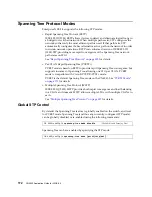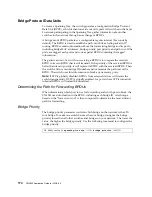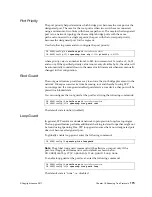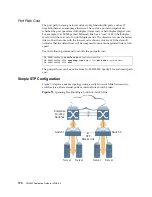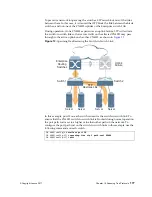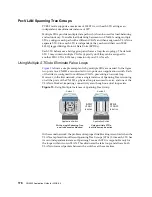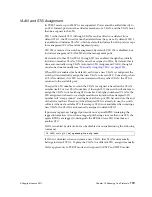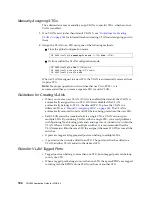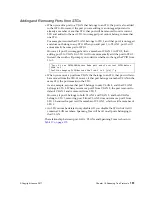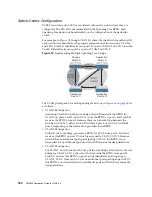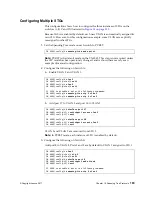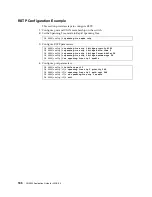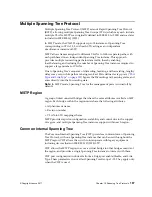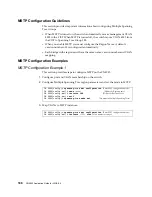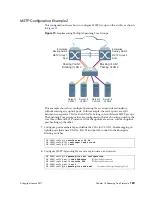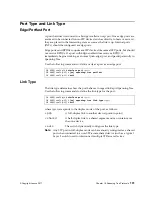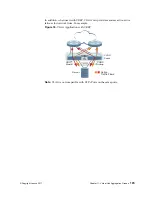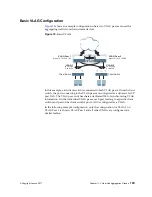
© Copyright Lenovo 2017
Chapter 10: Spanning Tree Protocols
185
Rapid Spanning Tree Protocol
RSTP
provides
rapid
convergence
of
the
Spanning
Tree
and
provides
the
fast
re
‐
configuration
critical
for
networks
carrying
delay
‐
sensitive
traffic
such
as
voice
and
video.
RSTP
significantly
reduces
the
time
to
reconfigure
the
active
topology
of
the
network
when
changes
occur
to
the
physical
topology
or
its
configuration
parameters.
RSTP
reduces
the
bridged
‐
LAN
topology
to
a
single
Spanning
Tree.
RSTP
was
originally
defined
in
IEEE
802.1w
(2001)
and
was
later
incorporated
into
IEEE 802.1D (2004),
superseding
the
original
STP
standard.
RSTP
parameters
apply
only
to
Spanning
Tree
Group
(STG)
1.
The
PVRST
mode
STGs
2
‐
128
are
not
used
when
the
switch
is
placed
in
RSTP
mode.RSTP
is
compatible
with
devices
that
run
IEEE
802.1D
(1998)
Spanning
Tree
Protocol.
If
the
switch
detects
IEEE
802.1D
(1998)
BPDUs,
it
responds
with
IEEE
802.1D
(1998)
‐
compatible
data
units.
RSTP
is
not
compatible
with
Per
‐
VLAN
Rapid
Spanning
Tree
(PVRST)
protocol.
Note:
In
RSTP
mode,
Spanning
Tree
for
the
management
ports
is
turned
off
by
default.
Port States
RSTP
port
state
controls
are
the
same
as
for
PVRST:
discarding
,
learning
and
forwarding
.
Due
to
the
sequence
involved
in
these
STP
states,
considerable
delays
may
occur
while
paths
are
being
resolved.
To
mitigate
delays,
ports
defined
as
edge
ports
)
may
bypass
the
discarding
and
learning
states,
and
enter
directly
into
the
forwarding
state.
RSTP Configuration Guidelines
This
section
provides
important
information
about
configuring
RSTP.
When
RSTP
is
turned
on,
the
following
occurs:
STP
parameters
apply
only
to
STG
1.
Only
STG
1
is
available.
All
other
STGs
are
turned
off.
All
VLANs,
including
management
VLANs,
are
moved
to
STG
1.
Summary of Contents for Flex System Fabric CN4093
Page 27: ... Copyright Lenovo 2017 27 Part 1 Getting Started ...
Page 28: ...28 CN4093 Application Guide for N OS 8 4 ...
Page 58: ...58 CN4093 Application Guide for N OS 8 4 ...
Page 72: ...72 CN4093 Application Guide for N OS 8 4 ...
Page 85: ... Copyright Lenovo 2017 85 Part 2 Securing the Switch ...
Page 86: ...86 CN4093 Application Guide for N OS 8 4 ...
Page 98: ...98 CN4093 Application Guide for N OS 8 4 ...
Page 112: ...112 CN4093 Application Guide for N OS 8 4 ...
Page 136: ...136 CN4093 Application Guide for N OS 8 4 ...
Page 156: ...156 CN4093 Application Guide for N OS 8 4 ...
Page 192: ...192 CN4093 Application Guide for N OS 8 4 ...
Page 228: ...228 CN4093 Application Guide for N OS 8 4 ...
Page 229: ... Copyright Lenovo 2017 229 Part 4 Advanced Switching Features ...
Page 230: ...230 CN4093 Application Guide for N OS 8 4 ...
Page 298: ...298 CN4093 Application Guide for N OS 8 4 ...
Page 382: ...382 CN4093 Application Guide for N OS 8 4 ...
Page 392: ...392 CN4093 Application Guide for N OS 8 4 ...
Page 416: ...416 CN4093 Application Guide for N OS 8 4 ...
Page 452: ...452 CN4093 Application Guide for N OS 8 4 ...
Page 466: ...466 CN4093 Application Guide for N OS 8 4 ...
Page 496: ...496 CN4093 Application Guide for N OS 8 4 ...
Page 508: ...508 CN4093 Application Guide for N OS 8 4 ...
Page 510: ...510 CN4093 Application Guide for N OS 8 4 ...
Page 514: ...514 CN4093 Application Guide for N OS 8 4 ...
Page 538: ...538 CN4093 Application Guide for N OS 8 4 ...
Page 539: ... Copyright Lenovo 2017 539 Part 7 Network Management ...
Page 540: ...540 CN4093 Application Guide for N OS 8 4 ...
Page 554: ...554 CN4093 Application Guide for N OS 8 4 ...
Page 576: ...576 CN4093 Application Guide for N OS 8 4 ...
Page 596: ...596 CN4093 Application Guide for N OS 8 4 ...
Page 604: ...604 CN4093 Application Guide for N OS 8 4 ...
Page 609: ... Copyright Lenovo 2017 609 Part 9 Appendices ...
Page 610: ...610 CN4093 Application Guide for N OS 8 4 ...
Page 626: ...626 CN4093 Application Guide for N OS 8 4 ...
Page 633: ......
Page 634: ...Part Number 00MY375 Printed in USA IP P N 00MY375 ...


